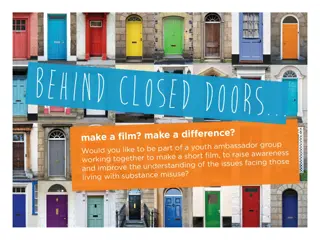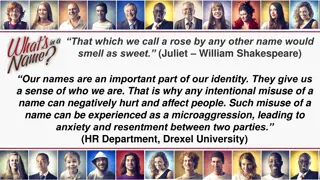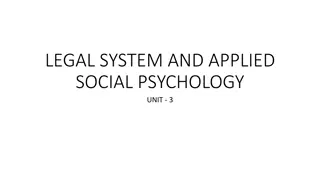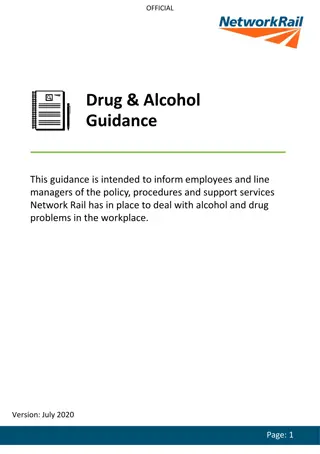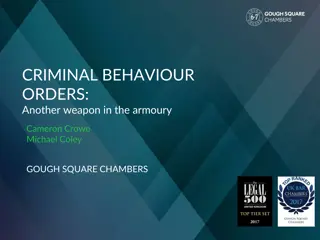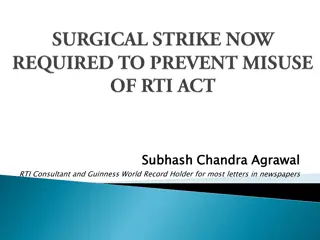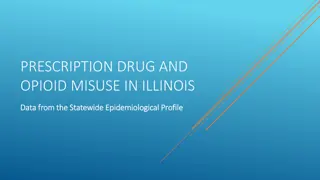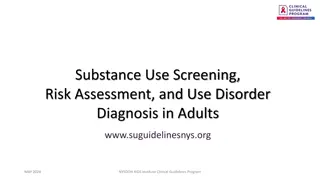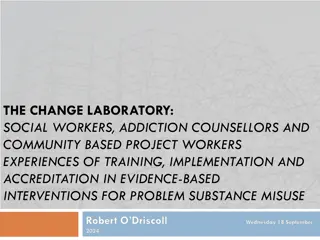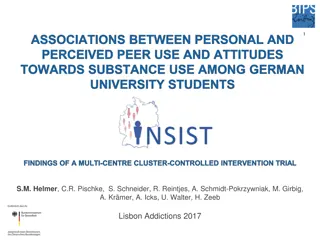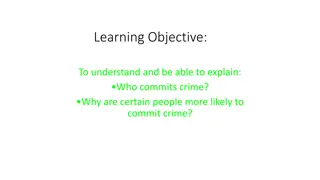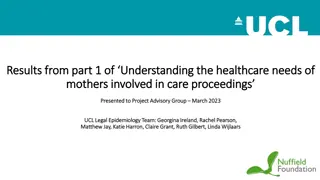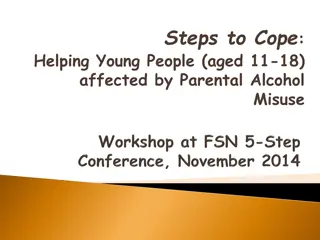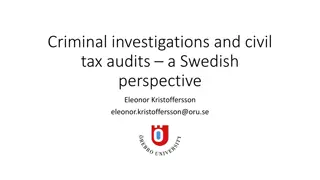The Statistical Association Between Substance Misuse and Criminal Behavior
This brief synthesis discusses the statistical association between substance misuse (specifically drugs and alcohol) and criminal behavior. It draws upon meta-analyses investigating the links between drug use and crime, as well as alcohol consumption and violent behavior. Various theories are explored, including enslavement theory, common causes theory, and co-existing problems theory. Additionally, different interactions linking substance abuse and criminal offenses are examined, along with the odds of offending for different drug users. The analysis highlights the complex relationship between substance misuse and criminal activities, emphasizing the need for comprehensive understanding and intervention strategies.
Download Presentation

Please find below an Image/Link to download the presentation.
The content on the website is provided AS IS for your information and personal use only. It may not be sold, licensed, or shared on other websites without obtaining consent from the author. Download presentation by click this link. If you encounter any issues during the download, it is possible that the publisher has removed the file from their server.
E N D
Presentation Transcript
Prof. M. H-Evans Reims University
A very short summary 5 minutes to summarise I shall mostlydrawupon: Bennett T., Holloway K., Farrington D. (2008), The statistical association between drug misuseand crime: A meta-analysis , Aggression and Violent Behavior, n 13: 107-118 (for drugs) And Lipsey, M.W., D.B. Wilson, M.A. Cohen & J.H. Derzon (1997). Is There a Causal Relationship Between Alcohol Use and Violence? A Synthesis of Evidence. In M. Galanter (ed.), Recent Developments in Alcoholism, Vol. 13: Alcoholism and Violence. New York: Plenum Press. (for alcohol) But alsoa few others
3 different theories Enslavement theory or economic necessity theory: people need a lot of money to buy drugs as they are expensive. Not always the case though (alcohol; market flooding; even heroine these days ) 2. Common causes theory : offendersand addicts have similar issues; so offending and addiction are caused by similar issues (in particular low self-control, personalitydisorders, antisocial cognitions, thoughts, attitudes and/or peers, genes ). Not always the case 3. Co-existing problems. People who abuse substances and people who offend both have problematic behaviour issues and are both part of a generallydeviant lifestyle/subculture. Not always the case does not explain alcohol 1. => A combination of these? les trois mon g n ral?
Different interactions Offencecommitted in order to purchase the substance; Offence triggered or supported by an impaired judgment (while intoxicated) ; Offence triggered or supported by impaired skills (e.g. drink driving); Offence triggered or supported by impaired inhibition (while intoxicated); Offence triggered or supported by substance induced callousness (eitherwhilst intoxicated or during withdrawal); In fewercases: intoxication in order to commit the crime => sometimesa combination of (part of) the above
Drugs Bennett et al., 2008 Oddsof offending are betwen 2.8 and 3.8 times greater for drug users than for non drug-users : Crack-cocaine: 6 times higher; Heroineusers: 3 times higher; Cocaine users: 2.5 times higher; Amphetamine users: 1.9 higher; Cannabis users: 1.5 higher. Pb: itdoes not account for differential treatment of different drugs
Drugs Another pb is: studies included in the meta-analysis do not focus on the sameoffences. Someon propertyoffences; others on violent offences. Strongerassociation is found with violence (Bennet et al.). For instance, regarding violence against women (a.k.a. domestic violence DV) another meta-analytic review of 96 studies (Moore et al., 2008) found that increases in drug use and drug-related problems were significantly associated with increases in DV (psychological abuse, violence, sex abuse) in aggression . The strongest association was found with cocaine.
Alcohol Lipsey et alii have focused mainlyon the alcohol and violence link Theydid find a strong correlation between alcohol and crime. Reminder: correlation does not mean thatalcohol causes offending. To sum up we re not sure that alcohol causes violence; we only think it possibly (partly) does (also see Ito, Miller & Pollock, 1996). Anothersimple rule is : it is not the principal factor. That being said alcohol is present in many cases and the person has committed the offence under the influence. And this is particularly truewith alcohol. For instance Khun et alii (2013) have conducted a meta-analysis of 23 studies totalling 28,265 homicides and found that the offender was under the influence in 37% of cases.
Alcohol A meta-analysis of 85 studies (Stith et al, 2004) found that five risk factors were strongly associated with DV, including, illicit drug use. Conversely only a moderate effect was found for 6 other factors, including alcohol use. But when one studies men entering treatment for alcohol use, one finds that about 50% of these men report having perpetrated VAW (which is about 5 times more than the general population) (Chermack et al., 1995) And manyalcohol abusing perpretators are fullyable of committing VAW whilst not intoxicated => a complex relationship to say the least! (Gondolf, 1999)
What does it mean in terms of treatment Do not hope that just by adding a treatmentobligation when the person abuses drugs or alcohol, you ll sort the problem out. But you do need to add a treatmentobligation. You do need to make sure substance abuse is dealtwith. However, it is not - & by far - enough. You also need to deal with othercriminogenic needs (e.g. antisocial beliefs, cognitions and attitudes, and peers; in manycases antisocial personality; employmentand attitude towards employment, family circumstances, etc.). Also, in manycases substance abuse hides (the person self- medicates) a mental health issue (bipolar psychosis, borderline personality, trauma ) which needs to be addressed
Conclusion Yes there isa link betweendrug and crime A strongerlink with - heroine - crack cocaine - cocaine - alcohol A lesserlink with Cannabis
Rfrences Bennett T., Holloway K., Farrington D. (2008), The statistical association between drug misuse and crime: A meta-analysis , Aggression and Violent Behavior, n 13: 107-118 Chermack, S. T., Fuller, B. E., & Blow, F. C. (2000). Predictors of expressed partner and non-partner violence among patients in substance abuse treatment , Drug and Alcohol Dependence, n 58,:43 54. Gondolf, E. (1999), Characteristics of court-mandated batterers in four cities: Diversity and dichotomies , Violence Against Women, n 5: 1277 1293 Ito T.A., Miller N. & Pollock V.E. (1996). Alcohol and Aggression: A Meta-Analysis on the Moderating Effects of Inhibitory Cues, Triggering Events, and Self-Focused Attention. Psychological Bulletin, n 120: 60 82. Khun J.B., Clodfelter T.A. & Bottia M.C. (2013), The Prevalenceof Alcohol-Involved Homicide offending: A Meta-Analycit Review , Homicide Studies, Online DOI: 10.1177/1088767913493629 Lipsey M.W., Wilson D.B., Cohen M.A. & Derzon J.H. (1997). Is There a Causal Relationship Between Alcohol Use and Violence? A Synthesis of Evidence. In M. Galanter (ed.), Recent Developments in Alcoholism, Vol. 13: Alcoholism and Violence. New York: Plenum Press. Moore T.M., Stuart G.L., Meehan J.C., Rhatigan D.L., Hellmuth J.C. & Keen S.M. (2008), Drug abuse and aggression between intimate partner s. A meta-analytic review , Clinical Psychlogy Review, n 28: 247-274 Stith, S. M., Smith, D. B., Penn, C. E., Ward, D. B., & Tritt, D. (2004), Intimate partner physical abuse perpetration and victimization risk factors: A meta-analytic review , Aggression and Violent Behavior, n 10: 65 98. West R. & Brown J. (2013), Theory of Addictions. Wiley
Merci! Thank you! http://herzog-evans.com martineevans@ymail.com martineeevans@gmail.com @ProfMEvans



